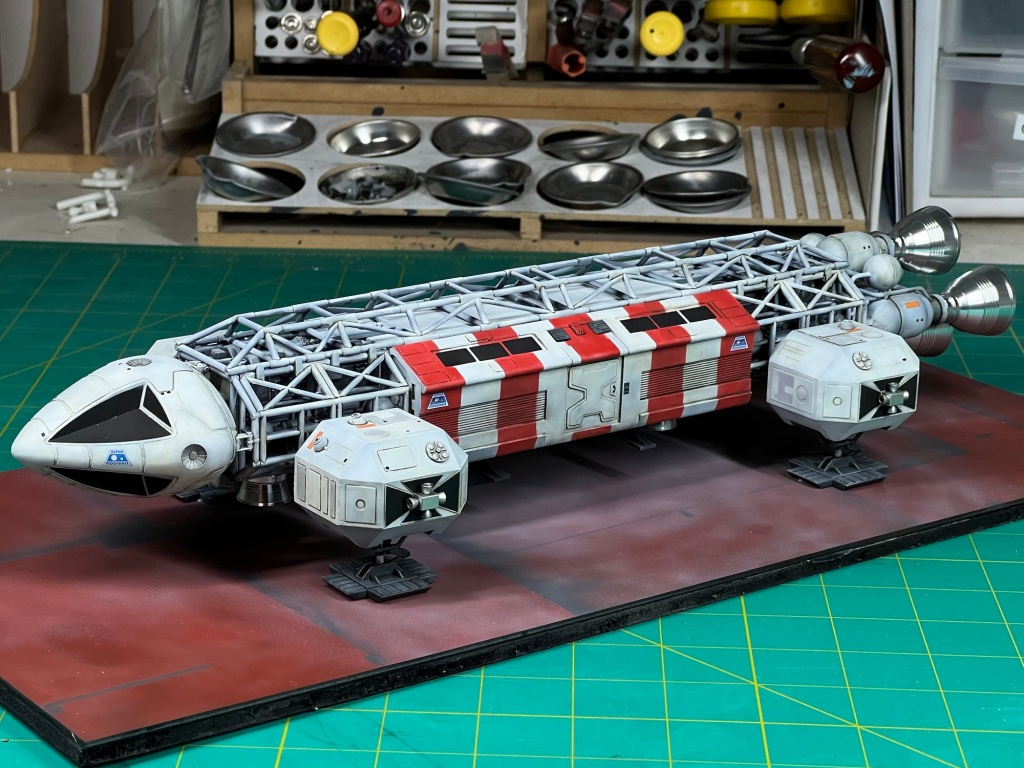
Long, long, ago, in the early-to-mid 70s, between Star Trek and Star Wars, space-based science fiction on the screen went through a dry spell. Stanley Kubrick’s 2001: A Space Odyssey set the pace with science fiction that leaned into the imagery and issues of the contemporary world and then-ongoing space programs. In other words, spacecraft and vehicles that showed up in movies and TV often looked not far off from Apollo and Soyuz, plot points seemingly fixed on out-of-control technology, environmental collapse, and occasional daring rescues. Stagnant effects. Lots of science, with a side of wooden, preachy fiction.
In those pre-Star Wars mid-70s years, tweenage me (and many others, apparently) blissfully lapped up whatever meager science fiction TV and movies were offered.
Enter Space:1999, a UK ITC series set roughly 25 years into the future that featured visuals mixing contemporary and 2001-like real space elements with vaguely Star Trek-like mod fashion and interior design. In its time, and for the genre, Space:1999 had fantastically high production values and was headlined by known actors from Europe and the US. Produced by the same creative team that had earlier produced Thunderbirds and U.F.O., it ran for two seasons.
Space:1999’s eminently improbable plot premise ticked the environmental and technological anxiety boxes: in Space:1999, the moon, with its Alpha Moonbase, is propelled out of the solar system on a voyage to strange new worlds when an over-accumulation of nuclear waste stored on the moon spontaneously explodes. Apropos of 70s TV, the premise provided screenwriters with an excuse for a steady cadence of alien- and/or rescue-of-the-week episodes.
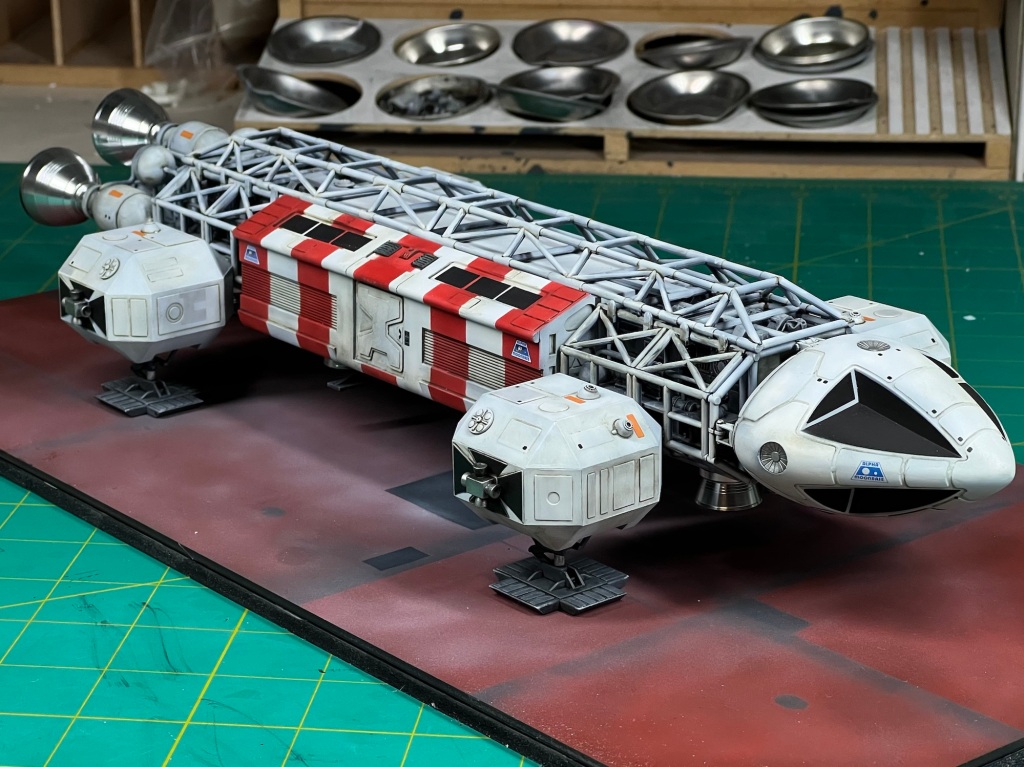
To tweenage me, Space:1999 was an exciting but frustrating enigma. Television was discouraged in my family, and the show’s UK origin meant that it aired at odd times on local TV channels, not during prime time on the big networks. When I was able to see it at a neighbor’s or relative’s, it was never a whole uninterrupted episode, and the plots were opaque. However, I was there for the spacecraft and special effects, and that’s what I still remember warmly.
(Space:1999 doesn’t hold up particularly well, by the way, and might even be unwatchable to 21st century viewers. Battlestar Galactica or Babylon 5 it ain’t!)
The hero spacecraft of Space:1999 were Eagle Transporters. Their iconic design was modular, with mission-specific variations appearing from episode to episode. Its visual features were borrowed directly from the styling of real Apollo- and Viking-era spacecraft. The engines, retro clusters, and landing gear, for example, look like they were lifted from Saturn rockets or Surveyor landers. The Eagle’s distinctive command module sports lines and colors that are reminiscent of the Space Shuttle and the Apollo lunar lander and crew capsule.
The Eagle also had a lot of texture—the builders of the Eagle filming miniatures incorporated greeblies, tonal variations, and stenciling that evoked real world aircraft and industrial machinery—before George Lucas introduced the lived-in, weathered Star Wars universe. In short, Space:1999’s Eagles were in many ways precursors to the iconic Star Wars look that set a new standard for screen science fiction.
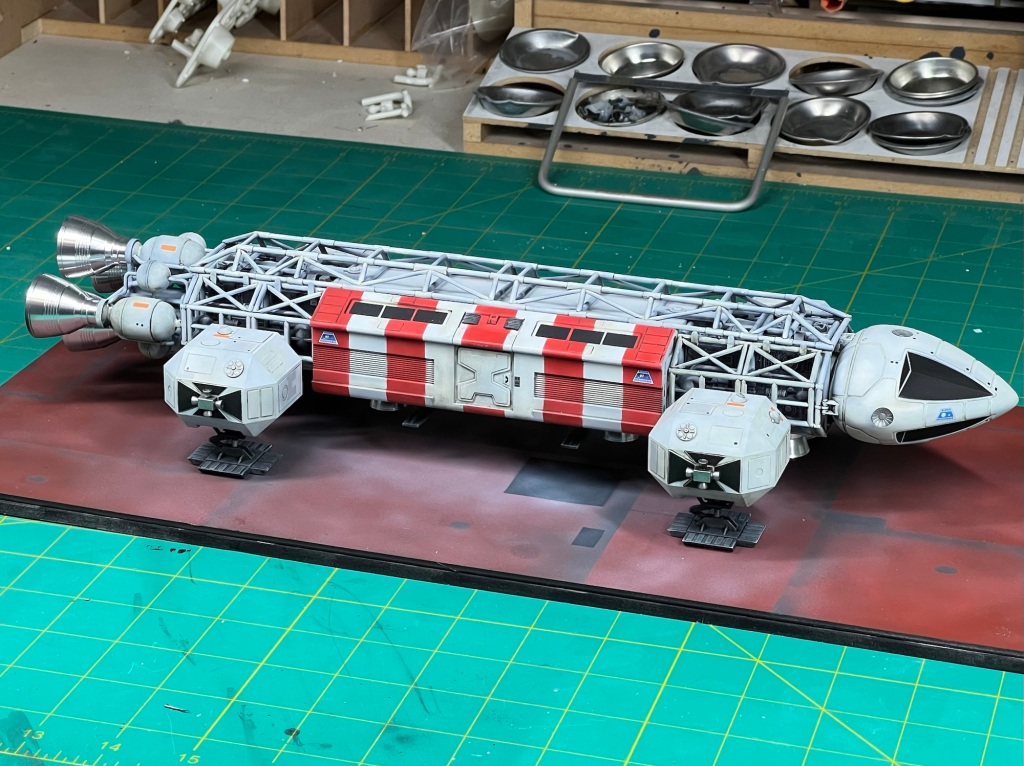
Model kits of Space:1999 subjects were on the market almost immediately upon the show’s release in 1975. MPC offered a 1/96 (though sometimes cited as 1/72) model kit of the Eagle, which was also boxed by Airfix. Not surprisingly, that old tool 1/96 kit doesn’t hold up to current standards, with generally incorrect proportions and simplified details. Though I lusted after that MPC Eagle, I was never able to acquire it until it was re-issued by Ertl sometime in the late 90s, along with much of the rest of AMT and MPC’s back catalog of licensed sci-fi subjects.
Happily, I have finally returned to my nostalgic childhood ambition of building an Eagle model using the Round 2/MPC 1/72 Eagle Transporter kit issued in 2019. MPC also offers a 1/48 Eagle kit, but this 1/72 version already measures out to 14”, a bit too big to comfortably fit in my display case. In comparison, the 22” long 1/48 model seemed downright monstrous; the 14” MPC 1/72 model worked out to be just enough model for me.
The 1/72 Eagle is molded in soft, off-white plastic with little flash, but some pronounced parting lines. Fit overall is remarkably good, particularly the lattice parts that click together to render a sturdy yet delicate-looking model. The nose command module and engine combustion chambers have some prominent yet easily addressed joint lines.
The ‘shoulder’ landing gear pods are the trickiest part of constructing the 1/72 Eagle. MPC engineered these parts with joints along natural corners but they must be aligned and sanded carefully to avoid gaps. Acrylic putty, which can be smoothed into cracks with wet cotton buds or tissue works well for these nearly inevitable cracks. I’m still not completely satisfied with how my landing gear pods turned out, but I got them close enough.
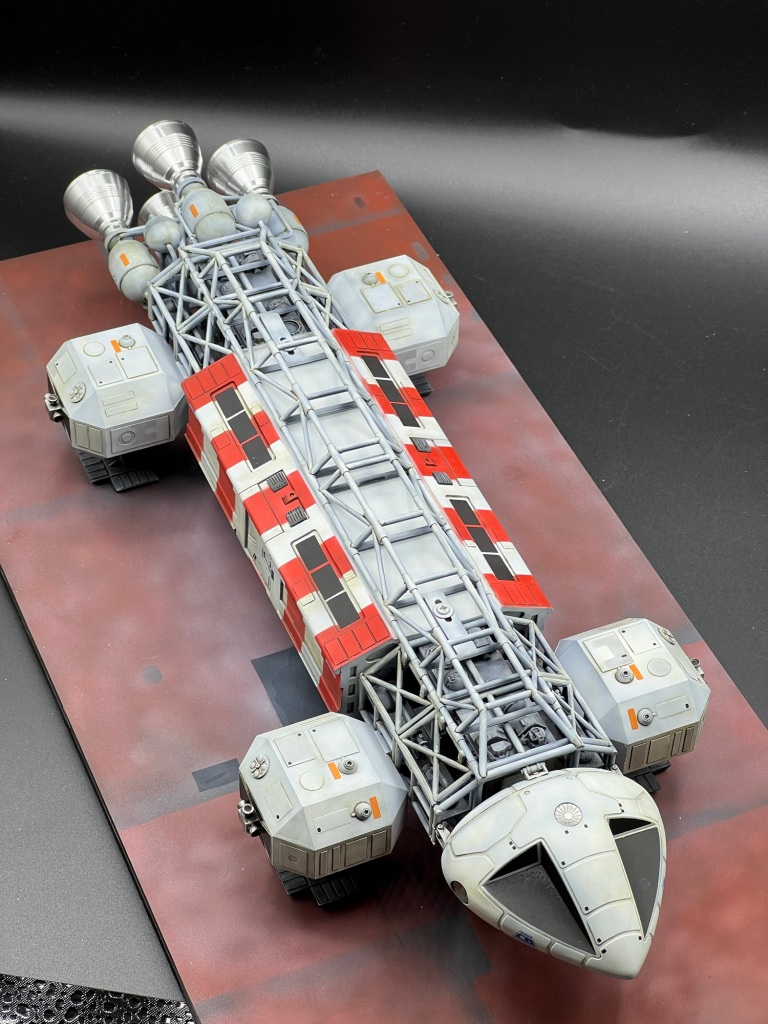
The complex lattice structures are among this kit’s best features, but their prominent parting lines require extensive, tedious cleanup. Ensuring paint coverage of the lattice frame structures and the internal machinery enclosed therein calls for careful preplanning and a subassembly approach.
The rear engine cluster and plumbing, like the lattice framing, fits extremely well but requires patience and more than a little wiggling and teasing to get all the parts into place. Test fitting is highly recommended, as well as a slow-setting cement to accommodate the flexing and momentary separations of parts needed to make it fit together as precisely as intended. The results are worthwhile: the engine cluster looks sufficiently ‘busy’, and it is sturdy.
Two aftermarket products vastly simplified and added significant joy to finishing my MPC Eagle: the Aztek Dummy MPC 1/72 masking set (available from the CultTVMan web store), and MPC’s own turned metal engine bell set.
After applying my customary Mr. Surfacer Black to all of the Eagle subassemblies, I began putting down the main colors, starting with the black bits of the nose and landing gear pods, for which I blended a shade of ‘off black’ or very dark brown from AK Real Flat Black and NATO Brown.
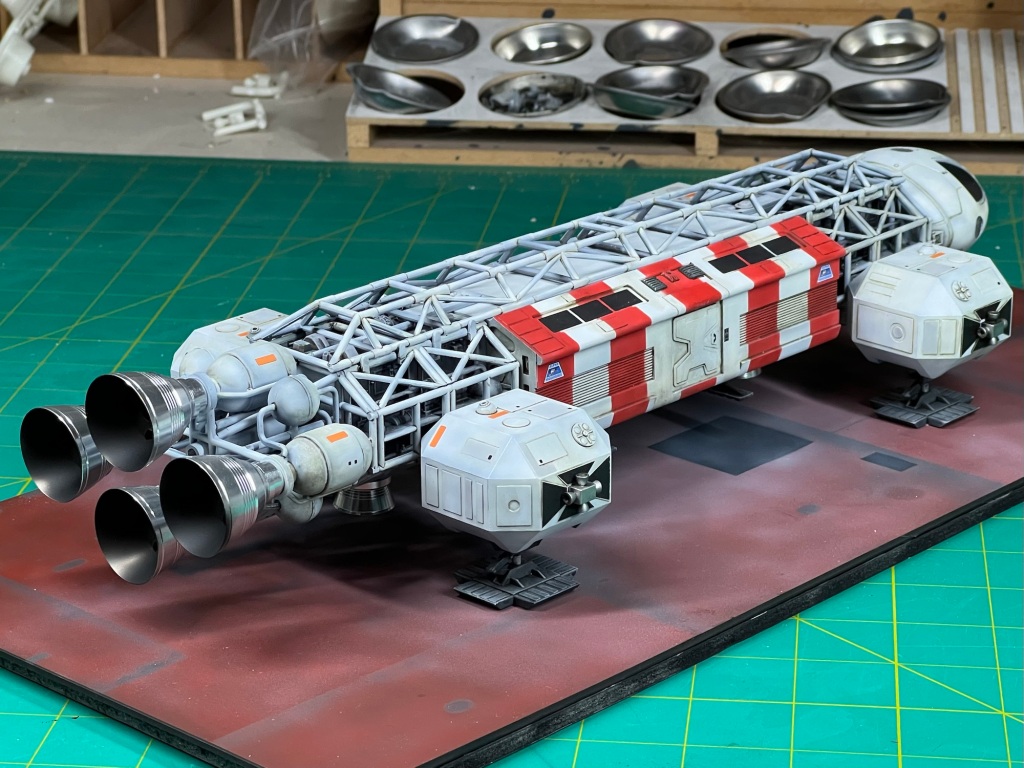
The Aztek Dummy masks were easy and quick to apply, paving the way for main color, white. I did not read the directions for the Aztek Dummy mask set, and did not realize until too late that cargo/passenger pod skylight frame masks are actually intended to be left on the model and represent some relief detail for those skylight windows. The three rectangles achieve much the same effect, but the frame detail would have looked better.
Just as I avoided a stark black, I used AK Real White Gray for the main color. Aztek Dummy helpfully provides masking or stenciling for individual panels and for the VIP and Rescue passenger pod schemes. The key to individual panel effects, as pointed out in the Aztek Dummy instructions, is low contrast variations in color; in this case, shades of ever so slightly darker grays. I chose the iconic Rescue pod scheme because it ‘pops’, and it also reminds me of the space concept art of science fiction illustrator Chris Foss, who often renders spacecraft in catchy striped and checked paint schemes.
I also applied decals while the model was still in subassemblies. Because I masked all the anti-glare, thrust deflection, and landing gear panels, I did not use most of the large decal sheet. MPC’s decal placement illustrations don’t differentiate between the three different versions of the Moonbase Alpha logos (white background is needed for the rescue pod) and are vague about the various stencils and orange panels.
MPC also didn’t provide enough of the small rectangular black stencils for placement as noted in their illustrations. I dug into my vast collection of leftover and aftermarket decals in search of something similar, perhaps some black striping that could be cut into small rectangles. An even better alternative presented itself: an ancient, 30+ year old Helvetica Medium dry transfer alphabet set. The dashes and periods turned out to be perfect matches for the small black stencils. And they were much faster to apply as well. How I miss dry transfers, a now bygone graphic arts technology with many uses for modelers.
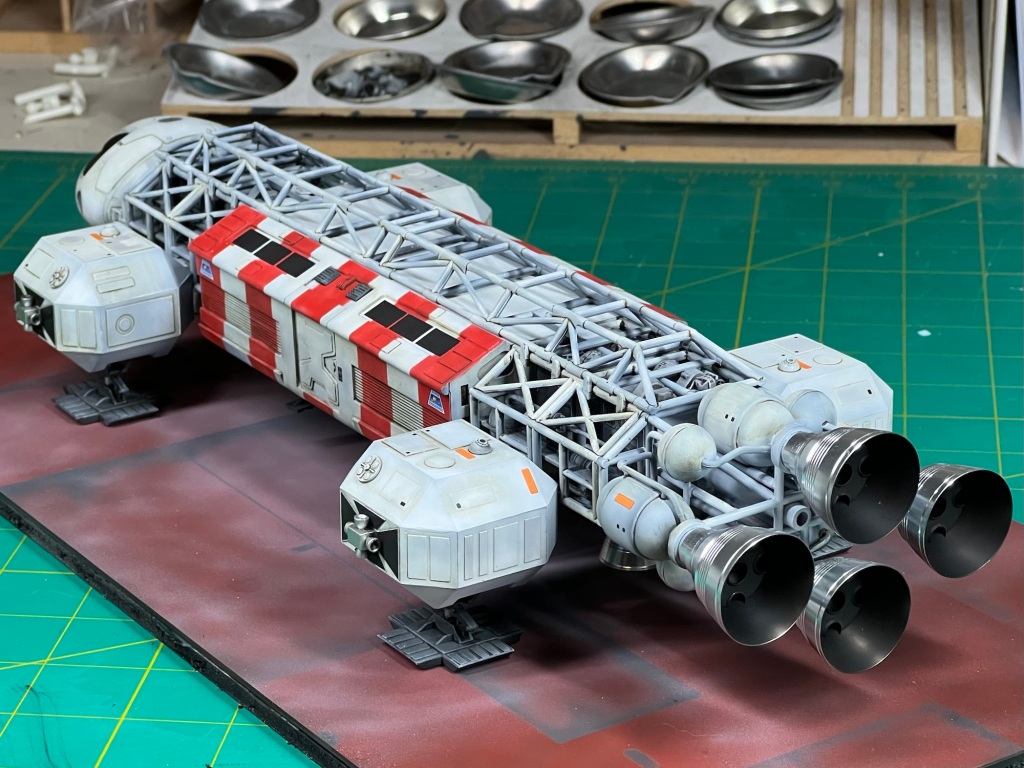
A gloss coat sealed the decals and dry transfers and served as foundation for a pinwash. I used a murky dull dark brown; kind of wished I went for more of a neutral gray. Nonetheless, I was satisfied with the results. An overall drybrushing of all the subassemblies with white acrylic was allowed to dry overnight before a final application of VMS Matte varnish—my first use of this product, and one I intend to incorporate into my regular repertoire going forward.
With the matt varnish dry, I assembled the subassemblies into the mostly complete model. MPC provides screws to attach the rescue pod to the main dorsal lattice spine, which are visible. Others gone through various machinations to hide or replace them; I touched them up with a spray of the AK White Gray base color.
With the Eagle mostly assembled, I turned my attention to the other aftermarket indulgence (and it was a pricey indulgence at that): MPC’s turned metal engine bells. I airbrushed Black Mr. Surfacer on the inside surfaces of all eight of the metal engine bells, and left the outside surfaces in their natural metal finish. I attached the four bottom bells with Tire Cement, a thick black CA glue, with the model resting on its back. The main rear engine bells fit snugly on the rear engine cluster assembly stems. I press-fit them into their respective stems, adjusted them for squareness, and then applied thin CA around the stem-bell joint inside the bell. An insert with engine interior detail helpfully covers the stem-bell joint.
Finally, a base for the Eagle, which I made from thick styrene sheet. Tamiya Hull Red, followed by panel lining with Tamiya Burnt Iron and Black fading demarcated with masking tape and sticky notes rendered a Moonbase Alpha deck. Some misting of light gray simulated lunar dust and landing engine wash. White glue attached the Eagle’s four big landing pads.
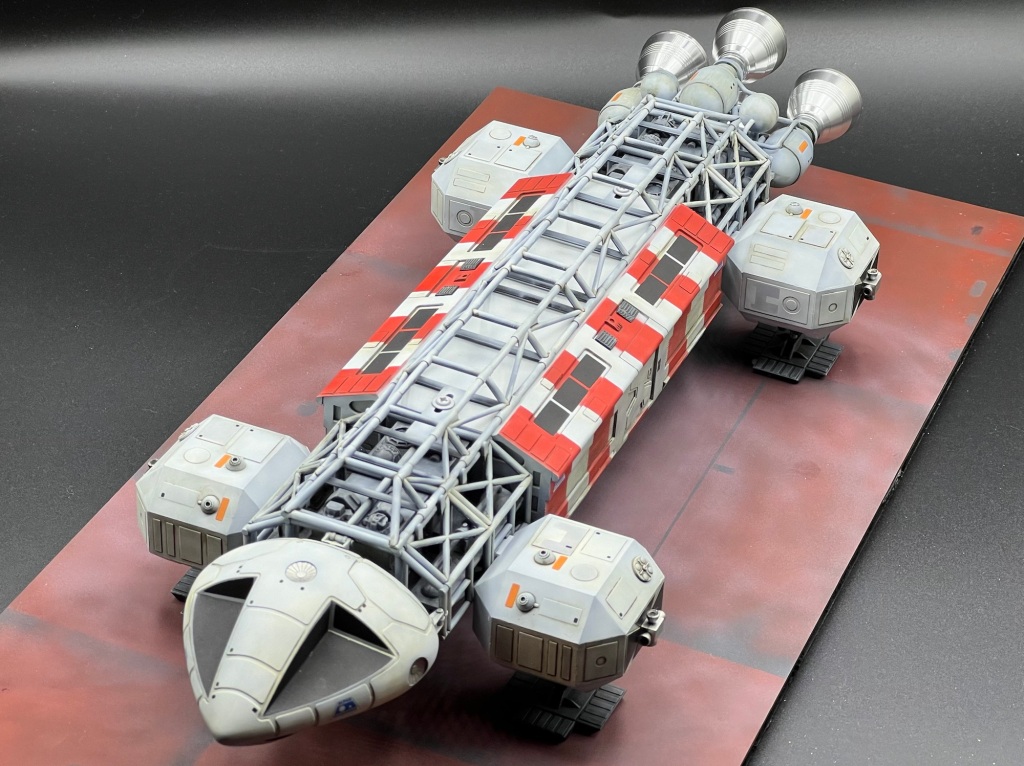
All in all, MPC’s 1/72 Eagle was a satisfying build. It’s the Eagle model I’ve had in mind for nearly 50 years, but could not produce until now.
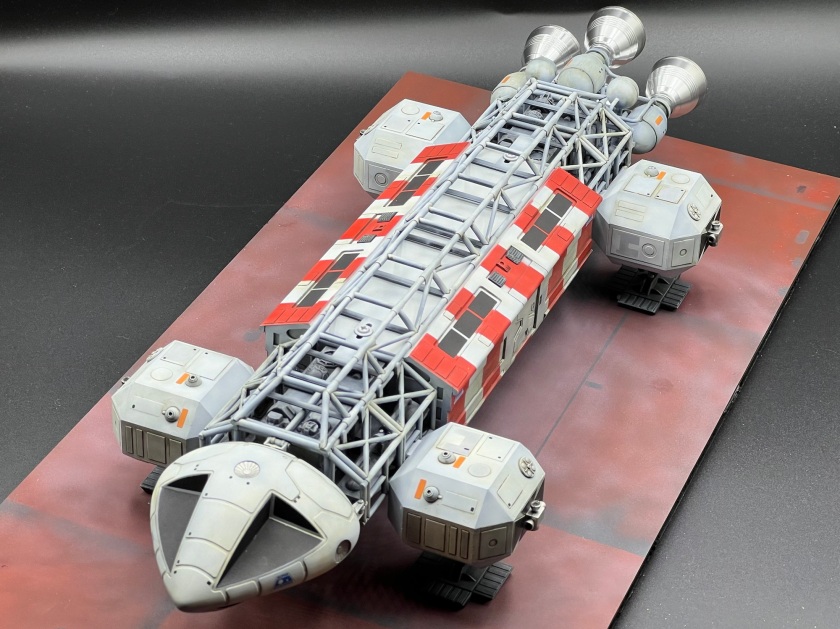
That turned out nicely! The Eagles are becoming popular, I’ve seen a few at the last few shows I’ve attended.
LikeLiked by 1 person
Thanks for the kind words, Jeff! Not surprised they keep turning up at the shows—it’s a compelling subject, and the new MPC kit gets a lot right.
LikeLiked by 1 person
That’s fantastic!
LikeLike